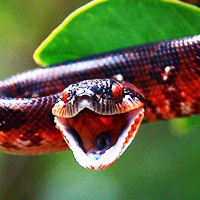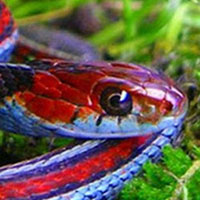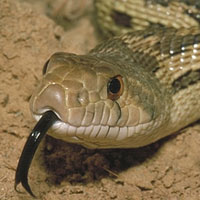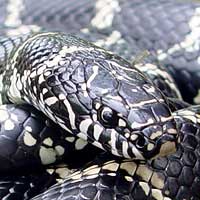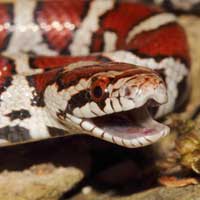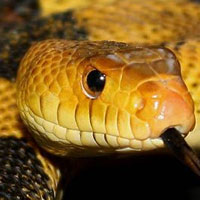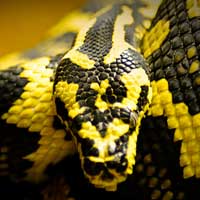All You Need to Know About the Diamond Python
The scientific name of the Diamond Python is Morelia spilota spilota, and it belongs to the Pythonidae family, which includes non-venomous constricting snakes commonly referred to as pythons.
Scientific Name: Morelia spilota spilota
Snake Family: Pythonidae
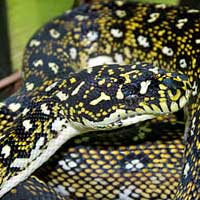
Introduction to the Diamond Python
The Diamond Python (Morelia spilota spilota) is a non-venomous snake native to Australia. Known for its striking diamond-like pattern, this python is a subspecies of the Carpet Python. Its calm temperament and manageable size make it a favorite among snake enthusiasts. This guide will take you through all aspects of the Diamond Python, from its natural habitat to its care requirements in captivity.
Exploring the Natural Habitat of the Diamond Python
The Diamond Python is endemic to the southeastern regions of Australia, where it inhabits a range of environments. Understanding its habitat is crucial for replicating its living conditions in captivity.
- Geographic Range: Found along the southeastern coast of Australia, including New South Wales and Victoria.
- Preferred Habitat: Forests, coastal heathlands, and suburban areas.
- Climate: Prefers temperate climates with moderate humidity levels.
| Region | Habitat Type | Key Features |
|---|---|---|
| New South Wales | Forests | Dense vegetation, moderate temperatures |
| Victoria | Coastal Heathlands | Open areas, high humidity |
| Suburban Areas | Backyards and gardens | Adaptable to human environments |
Diet and Feeding Habits of the Diamond Python
The Diamond Python is a carnivorous predator, feeding on a variety of prey in the wild. In captivity, its diet can be easily managed with proper planning.
- Natural Diet: Small mammals, birds, and reptiles.
- Feeding Frequency:
- Juveniles: Every 5-7 days for proper growth.
- Adults: Every 10-14 days, depending on their size and activity level.
- Captive Feeding Tips:
- Offer pre-killed, thawed rodents to ensure safety.
- Ensure the prey size matches the widest part of the snake’s body.
- Feed in a separate enclosure to prevent substrate ingestion.
Behavior and Temperament of the Diamond Python
The Diamond Python is known for its calm and inquisitive nature, making it a suitable pet for both beginners and experienced keepers. Understanding its behavior is essential for proper care.
- Activity Patterns: Primarily nocturnal, but may bask during the day in cooler weather.
- Defensive Behavior: Generally non-aggressive but may coil or hiss if threatened.
- Interaction with Humans: Tolerates handling well when accustomed to regular interaction.
With consistent handling and care, the Diamond Python can become a calm and manageable pet.
Health and Lifespan of the Diamond Python
With proper care, the Diamond Python can live up to 25-30 years in captivity. Ensuring their health requires careful attention to their environment and diet.
- Common Health Issues:
- Respiratory infections caused by low humidity or improper temperatures.
- Shedding problems (dysecdysis) due to insufficient humidity.
- Parasites such as mites and ticks.
- Preventive Measures:
- Maintain humidity levels between 50-70%.
- Provide a temperature gradient with a basking spot of 88°F-92°F.
- Ensure regular cleaning of the enclosure and veterinary check-ups.
Reproduction and Breeding of the Diamond Python
The Diamond Python is oviparous, meaning it lays eggs. Breeding them in captivity requires a well-managed environment and careful monitoring.
- Mating Season: Late winter to early spring.
- Clutch Size: Typically 10-20 eggs per clutch.
- Incubation Period: 60-70 days at temperatures of 86°F-88°F.
- Breeding Tips:
- Simulate seasonal changes to encourage breeding behavior.
- Provide a suitable nesting box with moist substrate.
- Monitor incubation conditions to ensure healthy hatchlings.
Handling and Caring for a Diamond Python
Handling and caring for a Diamond Python requires patience and knowledge to ensure its wellbeing. With proper care, these snakes can thrive and become rewarding pets.
- Enclosure Requirements:
- Minimum size: 4’ x 2’ x 2’ for adults.
- Include secure hides, climbing branches, and a water dish for soaking.
- Maintain a temperature gradient for thermoregulation.
- Handling Tips:
- Handle gently and support the snake’s entire body.
- Avoid handling during shedding or immediately after feeding.
- Wash hands before and after handling to maintain hygiene.
With consistent care and attention, the Diamond Python can provide years of enjoyment and fascination for its keeper.
Other Snakes In This Species
 Amethystine Python
Amethystine Python Ball Python
Ball Python Black-Headed Python
Black-Headed Python Boelens Python
Boelens Python Borneo Blood Python
Borneo Blood Python Burmese Python
Burmese Python Burrowing Python
Burrowing Python Centralian Python
Centralian Python Childrens Python
Childrens Python Coastal Carpet Python
Coastal Carpet Python Diamond Python
Diamond Python Green Tree Python
Green Tree Python Indian Python
Indian Python Inland Carpet Python
Inland Carpet Python Jungle Carpet Python
Jungle Carpet Python Macklots Python
Macklots Python Malaysian Blood Python
Malaysian Blood Python Olive Python
Olive Python Pygmy Python
Pygmy Python Reticulated Python
Reticulated Python Ringed Python
Ringed Python Rock Python
Rock Python Rough Scaled Python
Rough Scaled Python Spotted Python
Spotted Python Sumatran Blood Python
Sumatran Blood Python Timor Python
Timor Python White Lipped Python
White Lipped Python
